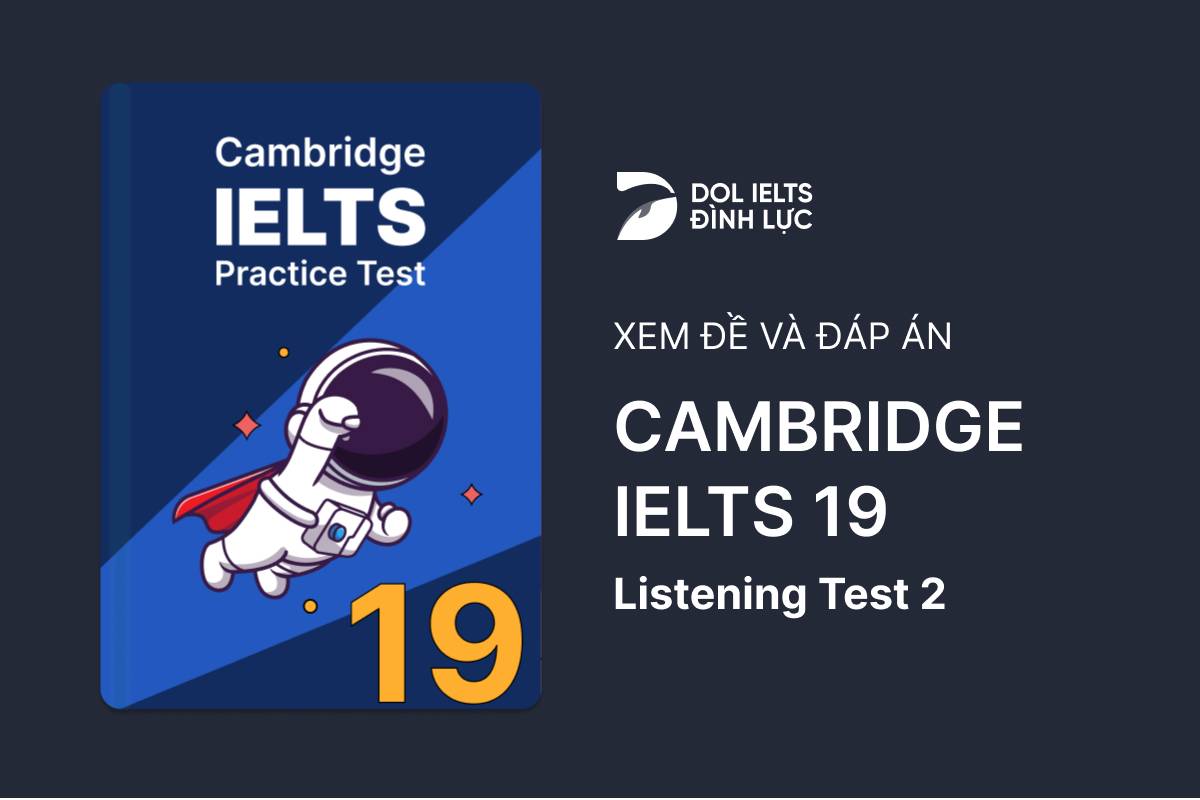Cambridge IELTS 19 - Listening Test 2 With Practice Test, Answers And Explanation
Luyện tập đề IELTS Online Test Cambridge IELTS 19 - Listening Test 2 được lấy từ cuốn sách Cambridge IELTS 19 với trải nghiệm thi IELTS trên máy và giải thích đáp án chi tiết bằng Linearthinking, kèm answer key và list từ vựng IELTS cần học trong bài đọc.
Section
👂️ Bài nghe section 1
Coordinator: Gary
Level:
Place: the
First Floor, Rom T347
Time: Thursday morning at
Recommended website: 'The Perfect
❓ Tapescript section 1
🔥 Đáp án & giải thích section 1
Giải thích chi tiết
Hello Dolbie 🤩 Cùng chinh phục câu hỏi này nhé 😁
🎯 Xác định loại từ cần điền: Một danh từ riêng (họ của người điều phối viên lớp học guitar).
▶️ Thông tin cần nghe ở: "He's called a 'coordinator' - his name’s Gary..."
☺️ Cùng xem giải thích nhé: Trong audio, người phụ nữ hỏi rõ họ của người điều phối viên ("How do you spell his surname?"), và câu trả lời được người đàn ông đưa ra là "Mathieson".
✅ Đáp án đúng: Mathieson
Section
👂️ Bài nghe section 2
❓ Tapescript section 2
🔥 Đáp án & giải thích section 2
Giải thích chi tiết
Hello Dolbie 🤩 Cùng chinh phục câu hỏi này nhé 😁
🌱 Đọc hiểu câu hỏi:
What made David leave London and move to Northsea? → Câu này hỏi lý do David quyết định rời khỏi London và chuyển tới sống ở Northsea. Các đáp án đề cập tới các lý do khác nhau:
A. Vì sở thích cá nhân
B. Để làm việc ít giờ hơn
C. Vì công việc không hài lòng
Dolbie cần tập trung vào lý do thực sự khiến David quyết định chuyển nhà.
Section
👂️ Bài nghe section 3
the high-heeled shoes
the ankle boots
the baby shoes
the trainers
❓ Tapescript section 3
🔥 Đáp án & giải thích section 3
Giải thích chi tiết
Hello Dolbie 🤩 Cùng chinh phục câu hỏi này nhé 😁
🌱 Đọc hiểu câu hỏi: At first, Don thought the topic of recycling footwear might be too... → Câu hỏi yêu cầu xác định suy nghĩ ban đầu của Don về chủ đề tái chế giày dép. → Dolbie cần nghe xem Don cảm thấy thế nào trước khi đọc bài báo, và điều gì làm thay đổi suy nghĩ của anh ấy.
A. limited in scope (phạm vi quá hẹp, không có nhiều thứ để nói)
B. hard to research (khó để nghiên cứu)
C. boring for listeners (nhàm chán đối với người nghe)
▶️ Bắt đầu nghe ở: "Well, before I started reading it, I thought recycling footwear, well, although it's quite interesting, perhaps there isn’t enough to say about it..."
☺️ Giải thích:
Section
👂️ Bài nghe section 4
Tardigrades
more than 1,000 species, 0.05 -1.2 millimetres long
also known as water 'bears' (due to how they
) and 'moss piglets'31
Physical appearance
a
round body and four pairs of legs32claws or
for gripping33absence of respiratory organs
body filled with a liquid that carries both
and blood34mouth shaped like a
with teeth called stylets35
Habitat
often found at the bottom of a lake or on plants
very resilient and can exist in very low or high
.36
Cryptobiosis
In dry conditions, they roll into a ball called a 'tun'.
They stay alive with a much lower metabolism than usual.
A type of
ensures their DNA is not damaged.37Research is underway to find out how many days they can stay alive in
.38
Feeding
consume liquids, e.g., those found in moss or
39may eat other tardigrades
Conservation status
They are not considered to be
40
❓ Tapescript section 4
🔥 Đáp án & giải thích section 4
Giải thích chi tiết
Hello Dolbie 🤩 Cùng chinh phục câu hỏi này nhé 😁
🎯 Xác định loại từ cần điền: động từ (mô tả cách tardigrades di chuyển) ▶️ Thông tin cần nghe ở: 'water’ because that’s where they thrive best, and ‘bear’ because of the way they move. ☺️ Cùng xem giải thích nhé: câu trong bài nghe giải thích rằng tardigrades có biệt danh là "water bears" vì cách chúng di chuyển. Động từ phù hợp mô tả sự di chuyển của tardigrades trong ngữ cảnh này là "move". ✅ Đáp án đúng: move 🧐 Dolbie lưu ý: ❌ walk
→ Sai vì "walk" thường chỉ áp dụng cho sinh vật có chân đi lại, trong khi tardigrades bò hoặc trườn. Chúc dolbie học tốt và tự tin hơn trong bài thi ielts nha 🥳💪


